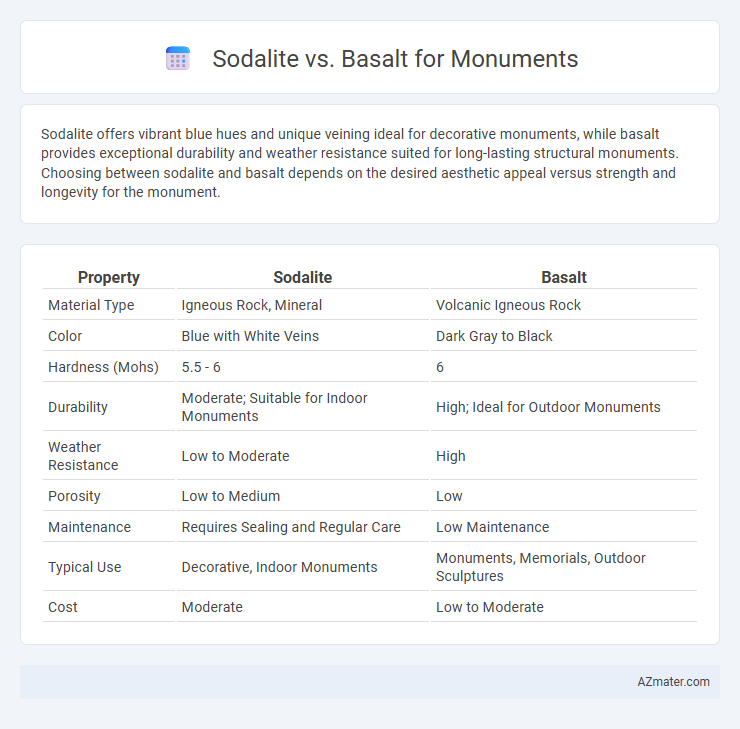Sodalite offers vibrant blue hues and unique veining ideal for decorative monuments, while basalt provides exceptional durability and weather resistance suited for long-lasting structural monuments. Choosing between sodalite and basalt depends on the desired aesthetic appeal versus strength and longevity for the monument.
Table of Comparison
| Property | Sodalite | Basalt |
|---|---|---|
| Material Type | Igneous Rock, Mineral | Volcanic Igneous Rock |
| Color | Blue with White Veins | Dark Gray to Black |
| Hardness (Mohs) | 5.5 - 6 | 6 |
| Durability | Moderate; Suitable for Indoor Monuments | High; Ideal for Outdoor Monuments |
| Weather Resistance | Low to Moderate | High |
| Porosity | Low to Medium | Low |
| Maintenance | Requires Sealing and Regular Care | Low Maintenance |
| Typical Use | Decorative, Indoor Monuments | Monuments, Memorials, Outdoor Sculptures |
| Cost | Moderate | Low to Moderate |
Introduction: Comparing Sodalite and Basalt for Monuments
Sodalite offers vibrant blue hues with white veining, making it a visually striking choice for monuments that demand aesthetic appeal. Basalt, a dense volcanic rock, provides exceptional durability and resistance to weathering, ensuring long-lasting structural integrity. Selecting between sodalite and basalt depends on the balance between ornamental value and longevity required for the monument project.
Geological Origins of Sodalite and Basalt
Sodalite is a rare, deep blue mineral formed primarily in silica-poor igneous rocks such as nepheline syenites, originating from alkaline magmatic processes that occur in continental rift zones. Basalt, on the other hand, is a common mafic volcanic rock produced by rapid cooling of low-viscosity lava at divergent and convergent tectonic plate boundaries, specifically in oceanic crust formation and volcanic islands. The contrasting geological origins of sodalite and basalt influence their mineral composition, durability, and aesthetic qualities, making sodalite prized for unique ornamental use, while basalt is favored for its strength and abundance in monuments.
Aesthetic Differences: Color and Texture
Sodalite exhibits a rich royal blue color interspersed with white calcite veins, creating a vibrant, striking appearance ideal for monuments requiring a visually captivating aesthetic. Basalt offers a more subdued, uniform dark gray to black color with a fine-grained, dense texture that provides a sleek, modern look suited for minimalist monument designs. The contrasting colors and textures between Sodalite and Basalt significantly influence the visual impact, with Sodalite emphasizing bold coloration and Basalt highlighting simplicity and elegance.
Durability and Weather Resistance
Sodalite and Basalt differ significantly in durability and weather resistance when used for monuments. Basalt, a dense igneous rock, offers superior durability and exceptional resistance to weathering, making it ideal for enduring harsh environmental conditions. Sodalite, while visually striking with its rich blue hues, is softer and more porous, rendering it less resistant to abrasion and prolonged exposure to moisture and freeze-thaw cycles.
Workability and Ease of Carving
Sodalite offers moderate workability due to its relatively softer texture compared to basalt, making it easier to carve fine details for intricate monuments. Basalt, being a dense and hard volcanic rock, poses challenges in carving and requires specialized tools and techniques, often increasing labor time and cost. The choice between sodalite and basalt ultimately depends on the desired finish and the complexity of the monument design, balancing durability with sculptural precision.
Cost Comparison: Sodalite vs Basalt
Sodalite is generally more expensive than basalt due to its rarity and vibrant blue coloration, making it a premium choice for monuments with distinctive aesthetics. Basalt offers a cost-effective alternative, valued for its durability and abundant availability, significantly reducing initial expenses. When comparing prices, basalt's affordability is advantageous for large-scale monument projects, while sodalite commands higher prices reflecting its unique mineral composition and visual appeal.
Maintenance Requirements for Monuments
Sodalite monuments demand careful maintenance due to their relative softness and susceptibility to weathering compared to basalt, which offers superior durability and resistance to abrasion. Basalt's dense, fine-grained structure requires minimal upkeep, making it ideal for long-lasting outdoor monuments exposed to harsh environmental conditions. Regular cleaning and protective sealing are necessary for sodalite to preserve its vibrant color and structural integrity over time.
Symbolic and Cultural Significance
Sodalite, known for its rich blue hues and association with wisdom and truth, has been prized in cultural artifacts symbolizing spiritual insight and clarity. Basalt carries deep historical and cultural significance as a volcanic stone often used in ancient monuments and sculptures, symbolizing strength, endurance, and resilience. The choice between sodalite and basalt for monuments reflects a preference for striking visual symbolism of intellect versus enduring physical presence rooted in historical legacy.
Environmental Impact of Quarrying
Quarrying sodalite for monuments involves extracting a rare, deep-blue feldspathoid mineral, which often requires deeper excavation and results in higher energy consumption compared to basalt. Basalt, a common volcanic igneous rock, is more abundant and accessible, leading to less environmental disturbance and lower carbon emissions during extraction. The ecological footprint of basalt quarrying typically impacts less biodiversity and soil erosion due to its widespread occurrence and shallower mining processes.
Final Recommendations: Choosing the Right Stone
Sodalite offers a striking blue color and fine texture ideal for decorative monuments requiring aesthetic appeal, while basalt provides exceptional durability and weather resistance, making it suitable for long-lasting outdoor installations. Select sodalite for monuments emphasizing visual impact and granite-like hardness, and choose basalt for structural integrity under harsh environmental conditions. Consider the monument's location, exposure to elements, and desired longevity when deciding between sodalite's ornamental beauty and basalt's robust performance.

Infographic: Sodalite vs Basalt for Monument
 azmater.com
azmater.com